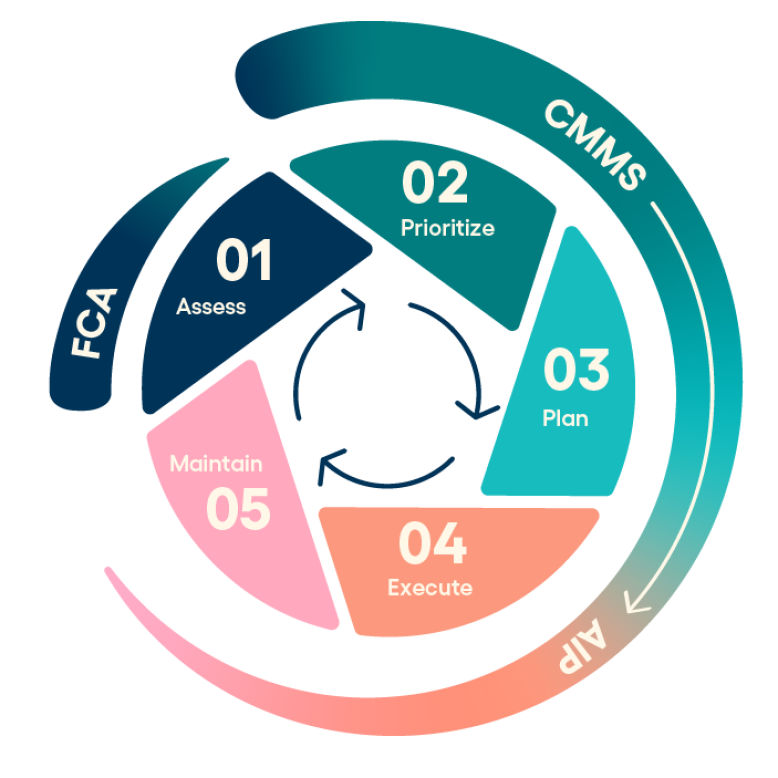Preparing for an FCA
Preparing for a facilities condition assessment (FCA) visit to your school district involves several steps to ensure a smooth and efficient evaluation process, both before and after the assessment:
- Review Previous Reports: Take some time to review any previous facilities condition assessment reports. Understand past findings, recommendations, and areas that might have been identified for improvement. This will help you focus on addressing any outstanding issues and track progress over time.
- Organize Historical Records & Documentation: Gather all relevant documentation related to your school facilities, including:
- building plans, cad drawings, engineering drawings
- maintenance records
- repair histories
- preventative maintenance schedule
- planned projects
- utility bills
- maintenance budget
Having this information readily available will facilitate the assessment process and enable evaluators to make informed judgments. - Conduct Pre-Assessment Inspections: Prior to the official assessment visit, conduct your own inspections of the facilities. Look for any visible signs of wear and tear, damage, or areas in need of repair. Note any safety hazards or code violations that need immediate attention.
- Prepare Maintenance Staff: Inform your maintenance staff about the upcoming assessment and provide them with any necessary instructions or guidance. Ensure that they are prepared to assist assessors during the visit and can provide additional information about maintenance procedures and schedules.
- Schedule Staff Interviews: Arrange interviews with key personnel involved in facilities management, including maintenance staff, custodians, and school administrators (superintendent, CFO, principals, athletics, etc.). These interviews can provide valuable insights into the condition of the facilities, ongoing maintenance practices, and any challenges faced in maintaining the buildings.
- Address Immediate Concerns: Prioritize addressing any immediate concerns or safety hazards identified during pre-assessment inspections. This could include repairing leaks, fixing broken equipment, or addressing structural issues.
- Plan for Access: Ensure that assessors have full access to all areas of the facilities during their visit. Coordinate with staff to unlock doors, provide access to equipment rooms, and make any necessary arrangements for access to restricted areas.
- Be Available for Questions: Designate a point of contact who will be available to answer any questions or provide assistance to assessors during their visit. This person should be knowledgeable about the facilities and able to provide accurate information as needed.
- Follow Up: After the assessment visit, be prepared to review the findings and recommendations provided by the assessors. Develop a plan to address any identified issues or deficiencies and prioritize them based on urgency and available resources.
- Keep Track of Progress: Update and follow up on any outstanding items to ensure that improvements are implemented effectively. This would be a great place to implement a CMMS system to streamline your facility's processes, including storing information from facility condition assessments (FCAs). CMMS software offers a convenient space to keep all relevant data from FCAs, such as schedules for preventive maintenance, records of equipment repairs, interactive mapping features, and utility usage tracking.
As with anything, arguably the most important part of being prepared for an FCA is having a plan.
If your goal is to strategically maintain your facilities, Brightly suggests the APPEM (pronounced app-em) model for continuous improvement. Aside from the fact that it can be used for virtually any process, it is also scalable, and facilitated by use of CMMS software.
The APPEM process is designed to create a cycle of success that is always up to date, avoiding the need to complete FCAs every 5 to 10 years.
- Assess thoroughly to understand all building components, assets, and systems – That's what we just did with our FCA.
- Prioritize urgent tasks, such as replacing carpet or repairing HVAC, organizing updates effectively.
- Plan the best way to address the items at the top (and bottom) of your list. Take note of what needs to be fixed when, how much it will cost and who needs to be involved to get the job done.
- Execute by updating the most critical items on your list, ensuring everyone has the tools (an easy-to-use work order management program) and direction they need to complete the task.
- Maintain your FCA by having a capital planning process, you can keep a close eye on each part of your facility and plan to prevent any unexpected maintenance or compliance issues.

When implementing the APPEM framework, the right software can contribute significantly to your ability to effectively manage the influx of data you've just received. A Computerized Maintenance Management System (CMMS) can streamline the entire process, storing data for future reference and facilitating both preventive and corrective maintenance tasks based on customized schedules. This enables you to monitor ongoing work and continuously enhance your tasks throughout the academic year.
Once your FCA is accurately updated and actively managed within your CMMS software, you can elevate your strategy even more and prepare for the future by integrating Asset Investment Planning (AIP) Software. AIP allows for proactive budgeting and long-term planning, empowering educational institutions to forecast major construction projects and capital investments several years ahead, particularly during summer periods.
In essence, an FCA enables you to assess your assets and plan upcoming projects, CMMS software helps keep your FCA current and maintain that data as you progress through the school year, and AIP software leverages your data to help you plan for the future by sustaining preventive maintenance, transitioning to proactive facility management, and strategizing for capital improvements and budgets in the years to come.




